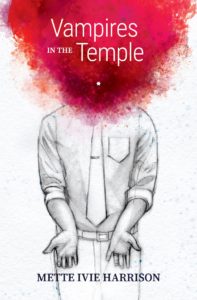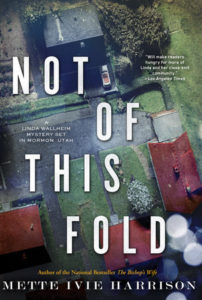 Mette Ivie Harrison. Vampires in the Temple. BCC Press, 2018.
Mette Ivie Harrison. Vampires in the Temple. BCC Press, 2018.
Mette Ivie Harrison. Not of This Fold. Soho Crime, 2018.
Reviewed by Julie L. Rowse.
(Cross-posted from the Dialogue: A Journal of Mormon Thought webpage)
I taught literature for a decade, and it’s sometimes hard for me to read a book and not see symbolism. The different critical approaches to literature are always in the back of my mind—ooh, here’s a feminist thread, ahh, there’s a biographical thread—but the further removed I am from teaching critical analysis of literature, the easier it’s become to just enjoy a story. And that’s what I tried to do as I read Mette Ivie Harrison’s Vampires in the Temple.
I’d seen Harrison tweet about the premise, and as a fan of her deliciously transgressive novel Book of Laman (2017), I knew I’d get my hands on Vampires one way or another. Vampires? Mormons? Werewolves? Mormons? How could such a story possibly connect?
Rather easily, actually. Though there are scenes of violence in the book, I didn’t spend the whole novel flinching. I suppose fans of horror would call that a criticism, but I kept wondering as I read, “Who is her audience?” If Harrison wanted to write a piece that could cater to anyone under Big Tent Mormonism, she attempted to accomplish just that. Horror for those in the faith who enjoy it, without ostracizing those who might just like a good murder mystery.
There’s some definite gore and violence that might make some readers queasy, but because I was dealing with creatures that don’t exist in my world, I wasn’t too bothered. That said, it was hard to put away my critical analysis hat and not see some metaphors for church operations. While it might seem outlandish that the LDS church has a dedicated section of followers to a fringe prophecy from a woman, anyone who has read anything about Julie Rowe (not me—note she does not have an S in her name) and her ilk, knows it’s possible. While it might seem incredible that the upper echelons of LDS leadership have secrets they do not want people to know, anyone who has followed any news of sexual assault in the LDS church knows better.
So while I had a great time racing through the story of Jack Hardy, the policeman protagonist, trying to solve his fiancée’s murder, something nagged at my subconscious: You’re not just reading a story.
Jack Hardy is not LDS, yet he is fully ensconced in and wary of the culture. He knows all is not well in Zion, and is convinced the church had something to do with his fiancée’s murder. While he is no fan of vampires (despite his own family genetic mutation), he isn’t convinced the vampires were responsible for her death.
I’m hesitant to imbue symbolism or agenda in an author’s work if it wasn’t intended, but as I read Vampires, I couldn’t help but think about the issues facing the LDS church today. First and foremost, transparency. While the Gospel Topics essay series and devotionals in which apostles grudgingly acknowledge blind faith might not be enough to answer questions, official church publications and events still shy away from their skeletons in the closet. And circling the wagons to keep the truth from even (or perhaps especially) the faithful is a core theme in Vampires.
Secondly, and most prescient, is how this lack of transparency harms children. As I write this, former Houston bishop Sam Young completed a hunger strike to end invasive questioning of children in bishop’s interviews, and my Catholic friends are reeling from a 1300 page report from a Pennsylvania grand jury about the scale of child sexual abuse at the hands of priests. The ways institutions–from churches to schools–harm children are reported on near-daily. Secrecy hurts everyone involved, and Harrison makes that clear in her novel.
Additionally, as I read about children being taken from their parents, placed for adoption, stripped of their identity as vampires—sure, it’s fantasy, horror, mystery—but it was impossible not to think of the Indian Placement Program the LDS Church facilitated for decades that attempted to eradicate Native children of their language and culture. Yes, at its core, Vampires in the Templeis horror, is mystery. However, it is also a cautionary tale that truth usually works its way out, and the upper echelons of any institution should figure out what side of history they want to be on.
 Fans of Harrison’s work get a double dose this year, as Soho Crime will release Not of This Fold, the fourth book in the Linda Wallheim mystery series, in time for the holidays. I’d only read The Bishop’s Wife, the first Wallheim mystery, as it’s the only book in the series my midwestern library carries. In Not of This Fold, Harrison goes into more explanation about the finer points of LDS culture. The book tackles how some members of the faith ostracize women who can’t have children, the impact of multi-level marketing businesses, how members co-opt pieces of the faith for financial gain, the tension between men wielding authority and the women who are subject to it.
Fans of Harrison’s work get a double dose this year, as Soho Crime will release Not of This Fold, the fourth book in the Linda Wallheim mystery series, in time for the holidays. I’d only read The Bishop’s Wife, the first Wallheim mystery, as it’s the only book in the series my midwestern library carries. In Not of This Fold, Harrison goes into more explanation about the finer points of LDS culture. The book tackles how some members of the faith ostracize women who can’t have children, the impact of multi-level marketing businesses, how members co-opt pieces of the faith for financial gain, the tension between men wielding authority and the women who are subject to it.
I finished this book the same day that Immigrations and Customs Enforcement raided a city not far from where I live, breaking up families and sending them to detention centers across the Midwest. Harrison’s plot of solving the murder of an undocumented immigrant felt prescient, but then I realized Harrison has simply been paying attention. I haven’t been.
What I love most about The Bishop’s Wife and Not of This Fold is how Harrison takes a world I’m familiar with—the Salt Lake Valley—and reminds me that religion is not necessarily a surefire way to creating Zion on earth. Bad people exist in every community, and religion isn’t a vaccination against evil. I remember when I read The Bishop’s Wife feeling a sense that Linda Wallheim was a little shocked that murderous people could live next door, could attend the same church. The Linda in Not of This Fold is much wiser, perhaps a little guarded and jaded, and I loved jumping the two intervening volumes to see that change in her.
As a Linda Wallheim mystery, the plot is formulaic: someone has died, and though the police are involved, Linda embroils herself in the investigation to eventually lead police to the killer. I was fairly certain early on who the killer was, but maybe Harrison’s modus operandi isn’t to keep a reader guessing. Maybe she wants readers to peek behind the church curtain and face some harsh truths about family, racism, and spiritual manipulation.
Though I consider myself progressive and long for the church to evolve into a more accepting and merciful institution, I do still get defensive when I read critiques of my faith tradition—and this work was no exception. The first chapter was so difficult for me to read, as Harrison establishes for the non-initiated how family-centric the church is. I am single, and I will not have any children. I am at peace with both of these realities in my life, and I attend and serve my local ward and stake and present as active in the faith. But I also perform quite a bit of cognitive dissonance to not lose my mind in realizing how I’m really a second-class citizen with the Saints. Harrison pulls no punches in the opening pages, as two characters square off over what The Church teaches a woman’s role truly is—wife-and-mother. While I found myself thinking “But that’s not doctrine” or “But not everyone treats me that way,” the truth is that privileging family is doctrine, and while I’m lucky to be surrounded by people who don’t outwardly judge me for my familial status, I have no idea what their internal judgments are.
Family idolatry was not the only LDS cultural point Harrison teases out as Linda teams up with her neighbor Gwen Ferris to try and solve the mystery of immigrant Gabriela’s murder. Explanations of racism and white saviorism also pepper the narrative. And while I was sympathetic to Gwen’s desire to help the members of the Spanish ward, her zeal in wanting justice for Gabriela read to me more like Gwen wanting to do penance for her inability to have children, her unenlightened past thoughts and behaviors, and perhaps those of the Church’s. I don’t think that’s a bad thing, necessarily, and perhaps Harrison is offering a warning to those who feel compelled to rush in and help the marginalized: decenter yourselves. It’s not about you.
But the most damning critique of this Wallheim tome is the connection between multi-level marketing companies and their apparent stranglehold on LDS culture. Harrison pulls no punches in crafting the world of the MLM “Celestial Security,” and hones in on how many MLM companies utilize LDS or Christian buzzwords, aesthetics, and tactics to rope in participants. Celestial Security is a textbook example of priestcraft, and even Linda Wallheim is uncomfortable with how the company uses the most sacred of spaces for business purposes. From using missionary-style language in trying to hook people to buy Celestial Security’s services, to the decor that resembled the interior of LDS temples, Harrison creates a fictional MLM business that I could see any average LDS member blindly trusting.
At the end of the day, Not of This Fold is an engaging murder mystery that should satisfy any fan of the genre. But if a reader is willing to get a little uncomfortable, she will find a story rife with examples of how blind obedience can be life-threatening.
I prefer non-fiction to fiction, because, as I tell my students, my brain can’t conjure stories any more fantastical than what I observe in real life. However, I am quick to point out to my students that good fiction writers utilize the fantastical, the mysterious, the seemingly incredible to bring awareness to universal issues that just might inspire readers to do something about injustices they see in the day-to-day. With Vampires in the Temple and Not of This Fold, Harrison has done exactly that. Will critics point to either novel as a bastion of the best literature has to offer? Perhaps not. But will attentive readers finish either novel and feel compelled to do something, anything, to affect change in their immediate spheres?
I sure hope so. We would all be better for it.
Julie L. Rowse’s essays have been published in Segullah and Midnight Circus, and her academic work has been published in the anthology Writing and the Digital Generation, and in the academic journals Quest and The World of Physical Culture in Sport and Exercise. Her memoir, Lies Jane Austen Told Me, was released in 2015. She holds a B.S. in Secondary Education with an emphasis in Language Arts from the University of Nebraska-Omaha, and an M.A. in Popular Culture from Bowling Green State University. She currently teaches journalism and Popular Culture Studies at a suburban high school.
